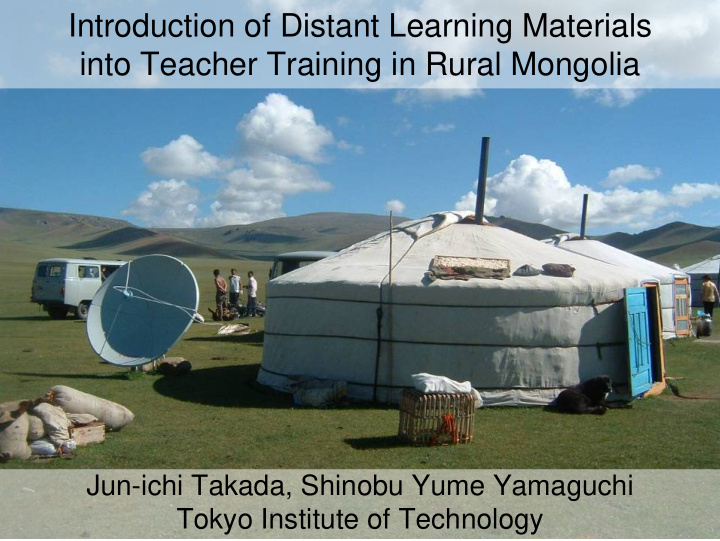



Introduction of Distant Learning Materials into Teacher Training in Rural Mongolia Jun-ichi Takada, Shinobu Yume Yamaguchi 1 Tokyo Institute of Technology
発表内容 背景 1. 教育分野における課題 A) プロジェクトの概要 B) 遠隔教材導入のための社会基盤整備の現状 C) 遠隔教育の導入について 2. 遠隔教育導入に関する調査 3. ガイドライン A) ラジオ番組 B) VCD 教材 C) 調査結果比較分析 4. 今後の課題・留意点 5. 2
Recent Incidents Related to Rural Schools in Mongolia • Transition from socialism to capitalism in 1990’s � Drop of budget for education in GDP: 11.5%(1990)->6.8%(1998) � Drop of student enrolment: 98%(1990)=>84%(1995) � New education law (2003): Child-centered approach � Regional gap in teacher training due to decentrarization • “Dzud”: natural disaster of extreme cold (2000-2001) � Death of 6,000,000 lifestocks (1/3 of whole Mongolia) � Affects of “Dzud” to Schools � Destruction of school building and dormitory � Damage of heating system � Loss of study time � Decline of teachers’ motivation � Migration of teachers to cities 3
Project Outline Building Rehabilitation and UN Teacher Recurrent Training Human Security Fund Project in Gobi Provinces Budget Tokyo Tech UNESCO Mongolian Govt • Global Scientific and UNICEF Information Center Ministry of Education • Department of International Rural Schools Development Engineering 20 schools Technical in 3 provinces Assistance Project Team Survey of Reusable Energy Building Rehabilitation Means of Distant Training Teacher Recurrent Training 4
Zavkhan Ulan Bator Uliastai Mandalgobi Jaargalant Dundgobi Bayankhongor 1000 km Mobile Training •Lecturers move by cars •Low population density •Lack of public transportation 5 => Distant learning Dundgobi
Status of Infrastructure for Deploying Distant Learning Media • Electrical power network – Dundgobi: connected to central grid – Bayankhongor, Zavkhan: village or school generator • Village level: hydro, diesel (stopped due to oil expense) • School level: engine generator, solar panel 6
Status of Infrastructure for Deploying Distant Learning Media • Communication network – Telephone available only in telecenter in the village – No Internet access 7
Status of Infrastructure for Deploying Distant Learning Media • Media appliances – National radio (LF/HF): whole country – Satellite TV: parabolic dish, more popular than terrestrial TV – Audio cassette player – VCD player: combination with TV, driven by solar cell 8
Production of distant learning materials Radio program Guidelines 6 Subjects • Content based on teachers ’ • Being aired in May, June (6 times X 2) • Science concrete questions • Mathematics & Informatics • 15- 20 min, 6 program and its repeat next day • Human Science • Complementary materials to • Group training is highly recommended radio program and VCD • Art and technology • History & social science • Contents developed by SUoEd and Institute • Teachers & student communication of Education • 2,500 USD to develop and air program National Project Team • Nationwide coverage of the program State University of Education Manual Contents • Departments according to the 6 selected • Post- graduate training Audio cassette material subjects: (Natural Science, Mathematics & department informatics, Humanities, Art & Technology, History and Social Science) • 300 copies are to be distributed in June VCD production • Half of schools in Mongolia are to be covered • School of Mongolian Language, Department of Journalism • Unit in distant education VCD material National Radio Station Ministry of Education Institute of Education • Content is 25 min • Collaboration in • Technical assistance and • Educational Policy developing contents airing in radio program • 4,500 USD to develop material • School of Mongolia Language & Art • 6 subjects, 10 lessons Needs assessment for teachers • Material testing in summer training • Baseline survey, May 2004 9 Feedback • Questionnaire for teachers, Nov. 2004 • Additional response from teachers, Dec. 2004
Evaluation of Distant Learning Materials Observation of Infrastructure Questionnaires 10 Interview in Training
Mobile Teacher Training • Date: July 30 – August 17, 2006 • Participants Province School Participants Zavkhan Uliastai Devshil 78 (from 7 villages) Bayankhongor Jaagalant 77 (from 8 villages) Dundgobi Mandalgobi Saintsaagan 124 (from 8 villages) 11
Executive Summary Useful Media for Future Training Zavkhan Bayankhongor Dundgobi Guideline 48% (26) 31% (12) 48% (36) Radio program 6% (11) 28% (11) 21% (16) VCD 61% (33) 89% (35) 69% (52) Mixed use 20% (11) 21% (8) 39% (20) • VCD is highly appreciated. – Use of solar cell Training in small group – VCD player at home at home Interest in • Radio is not preferred. mixed use – Time constraint – Impression of “old medium” • Guideline is still useful. 12 – No appliances
Issues and Future Tasks 1. Enhancement of VCD materials • Improvement of audio and visual quality • Experiments and model lectures • More titles to cover wide subjects 2. Electrical power supply • Reusable energy, e.g. solar cell – policy 3. ICT infrastructure • Rapid change due to progress of technology • Internet training facility available in provincial capital • Best media always changing 4. Complement, not replacement • Mobile training is still needed. 13
Project Sustainability • Use of available and affordable technology – Running cost is majority in ICT. – Advanced technology needs more expensive human resource (technician), which may drain after project. • Matching with needs – Distant training materials do not work alone. – How to use materials in training should be carefully considered and provided to teachers. 14
15 Training in Uliastai, Zavkhan
16 Training in Uliastai, Zavkhan
Recommend
More recommend